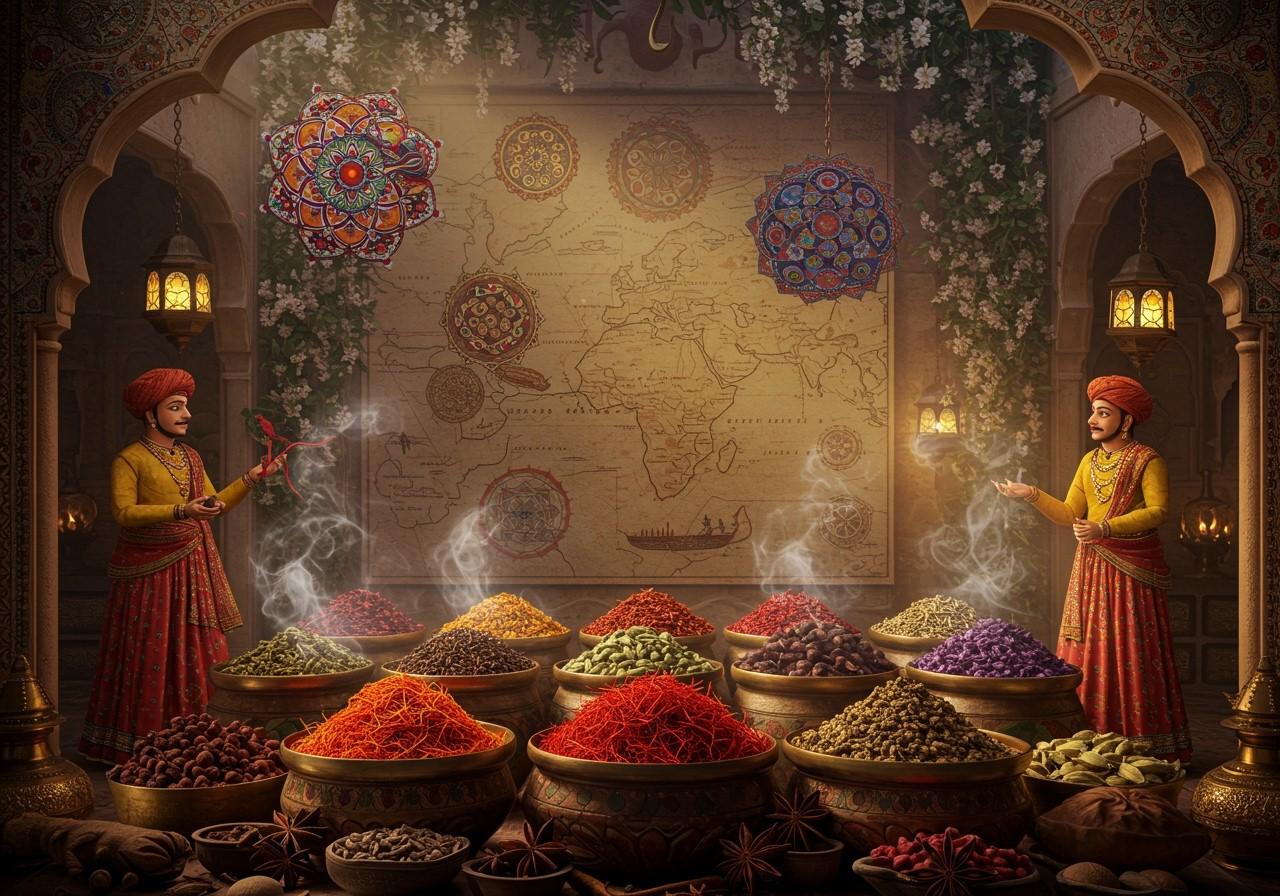
The ancient spice trade stands as a testament to the interconnectedness of diverse cultures and civilizations. It wasn’t merely an exchange of goods, but a vibrant conduit for the flow of ideas, traditions, and culinary practices. While cinnamon, ginger, and pepper often take center stage in historical narratives, a plethora of other aromatic spices played pivotal roles in shaping ancient gastronomy and cultural landscapes. This exploration delves into these forgotten spices, tracing their origins and the intricate trade routes that brought them to the ancient world.
Saffron’s Golden Journey Through Time
Saffron, often revered as “red gold,” boasts a captivating history. Derived from the Crocus sativus flower, it was treasured by ancient Persians, Egyptians, and Greeks for its vibrant hue, distinctive flavor, and medicinal properties. Trade routes for saffron extended from Iran and Kashmir, reaching the far corners of Europe and Asia. The labor-intensive harvesting process elevated saffron to a luxury commodity, gracing culinary creations, religious rituals, textile dyeing, and the crafting of exquisite perfumes. Its passage along the Silk Road underscores its significance in ancient commerce.
Black Pepper: The King of Ancient Spice Routes
Black pepper, frequently hailed as the “king of spices,” reigned supreme in ancient trade. Originating from the Malabar Coast of India, its pungent allure captivated Greeks, Romans, and Egyptians alike. Pepper served not only as a seasoning and preservative but even as a form of currency. Trade routes for this prized commodity encompassed both the terrestrial Silk Road and maritime passages through the Arabian Sea and Red Sea. The insatiable demand for black pepper fueled the growth of trade networks and brought economic prosperity to regions like Kerala.
Unearthing the Forgotten Spices of Antiquity
Beyond the prominent pepper and cinnamon, a constellation of lesser-known spices held significant sway in ancient trade:
- Long Pepper: This spice, a close relative of black pepper, enjoyed widespread use in Roman and Indian cuisines, adding its distinctive heat to a variety of dishes. Its popularity waned as black pepper became more readily available.
- Grains of Paradise: Native to West Africa, grains of paradise tantalized palates with their intriguing blend of peppery and citrusy notes. This spice was highly sought after in Europe during the Middle Ages and Renaissance, adding complexity to both sweet and savory dishes.
- Cubeb: Hailing from Indonesia, cubeb, a type of pepper, was prized for its medicinal properties, believed to aid digestion and alleviate respiratory ailments. It also found its way into culinary preparations, offering a warm, slightly bitter flavor.
- Mace and Nutmeg: These two spices, derived from the nutmeg tree, became indispensable in medieval European cooking. Mace, the outer covering of the nutmeg seed, offered a delicate, warm flavor, while nutmeg provided a richer, more intense aroma.
- Lesser Galangal: Similar to ginger, lesser galangal, with its earthy and citrusy notes, played a prominent role in Southeast Asian and Middle Eastern dishes. Its use extended beyond culinary applications, as it was also valued for its medicinal properties.
These forgotten spices offer a glimpse into the remarkable diversity of the ancient spice trade.
Navigating the Ancient Spice Routes
The flourishing ancient spice trade relied heavily on a network of well-established trade routes:
- The Silk Road: This iconic land route served as a vital artery connecting East and West, facilitating the exchange of spices, silk, and other luxury goods. Spanning thousands of miles, it played a crucial role in fostering cultural exchange and economic growth.
- Maritime Routes: The maritime Spice Route, traversing the Indian Ocean, Arabian Sea, and Mediterranean, played a crucial role in connecting distant lands. Navigators relied on monsoon winds to traverse these waters, carrying precious spices to eager markets.
- Red Sea and Persian Gulf: These strategic waterways acted as crucial trade hubs, linking Africa, Asia, and Europe. They facilitated the movement of goods, including spices, between these continents, contributing significantly to the global spice trade.
- Hanseatic League Routes: The Hanseatic League, a powerful medieval trade alliance, established extensive trade routes across the Baltic and North Seas, extending the reach of the spice trade into Northern Europe. This network enabled the distribution of spices throughout the region, shaping culinary traditions and influencing local economies.
Understanding these routes illuminates the intricate web of connections that bound ancient civilizations.
Poojn.in: Your Gateway to Traditional Spices
For those seeking to experience the authentic flavors of ancient spices, poojn.in offers a curated selection of traditional spices, including Kabab Chini (Piper Cubeba). Our commitment to quality ensures that you receive 100% pure spices, free from added perfumes, carefully packaged to preserve their freshness and aroma. Whether for culinary endeavors or religious ceremonies, poojn.in provides convenient online access to a variety of spice options, including:
- Kabab Chini (All Spice Berries)
- Turmeric (Haldi)
- Black Pepper (Kali Mirch)
- Cinnamon (Dalchini)
- Cloves (Laung)
- Cardamom (Elaichi)
Visit www.poojn.in today to explore our diverse collection and embark on a sensory journey through the rich history of spices.
Embracing the Enduring Legacy of Ancient Spices
The ancient spice trade stands as a testament to human ingenuity, the pursuit of culinary excellence, and the desire to connect across cultures. While pepper and cinnamon remain familiar staples, delving into the world of forgotten spices like saffron, long pepper, and grains of paradise enriches our understanding of history and expands our culinary horizons. As we rediscover the unique flavors and health benefits of these ancient treasures, we forge a deeper connection with our shared heritage. Online platforms like poojn.in bridge the gap between tradition and modern convenience, bringing these aromatic gems to our doorstep. Embracing the enduring legacy of ancient spices allows us to honor the past while enriching our culinary experiences for the future.
Explore more about the fascinating world of spices and cultural traditions on poojn.in:
- Incense: Art, Science, Puja & Aromatherapy – A Complete Guide
- Karnataka’s Ancient Temples: A Spiritual Journey


